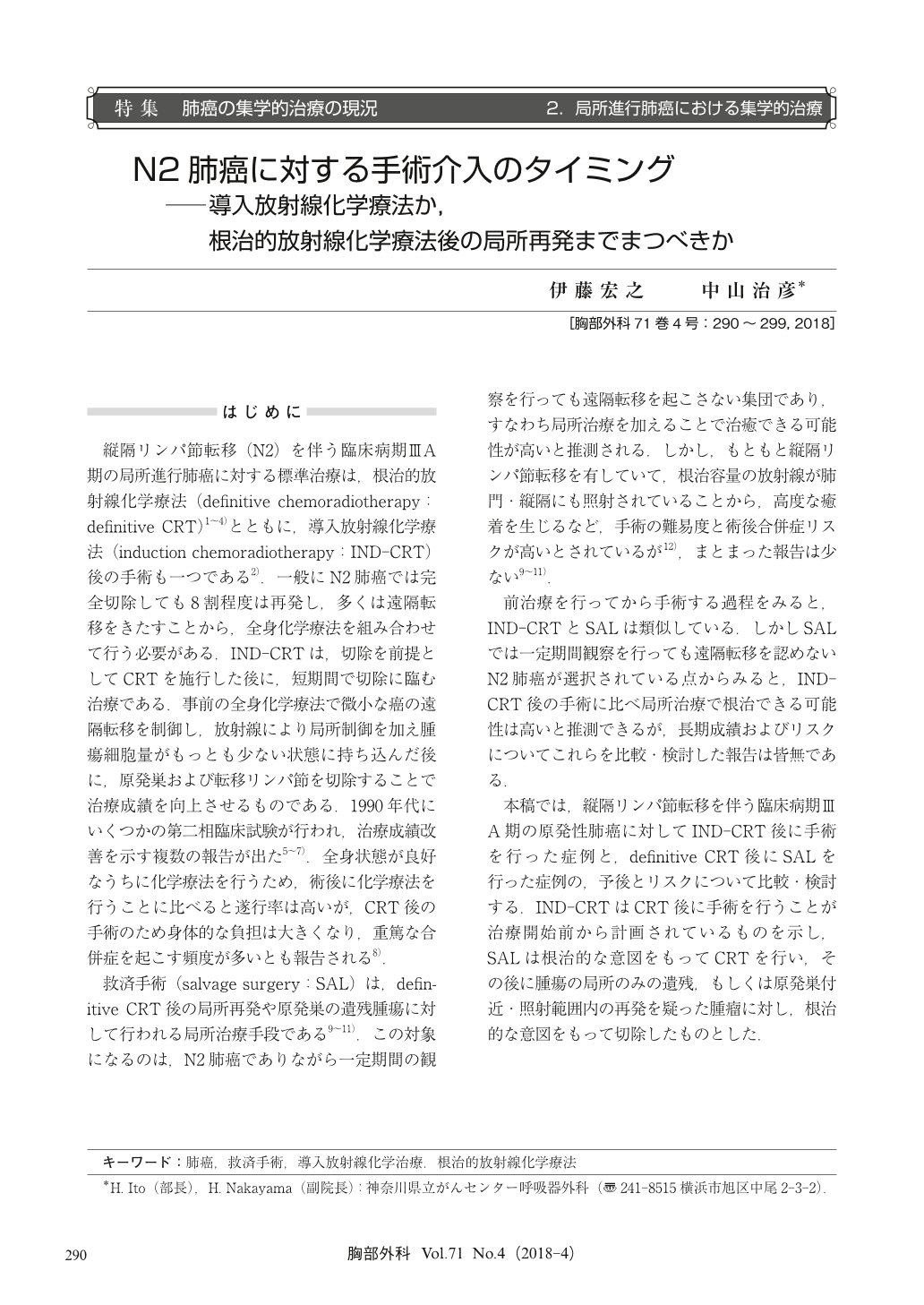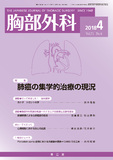Japanese
English
- 有料閲覧
- Abstract 文献概要
- 1ページ目 Look Inside
- 参考文献 Reference
縦隔リンパ節転移(N2)を伴う臨床病期ⅢA期の局所進行肺癌に対する標準治療は,根治的放射線化学療法(definitive chemoradiotherapy:definitive CRT)1~4)とともに,導入放射線化学療法(induction chemoradiotherapy:IND-CRT)後の手術も一つである2).一般にN2肺癌では完全切除しても8割程度は再発し,多くは遠隔転移をきたすこと
Background:Standard treatment for locally advanced clinical N2 lung cancer is definitive chemo-radiotherapy, and induction chemoradiotherapy(IND-CRT)followed by surgery is an option. Most of them recurs remotely within a few years after initial therapy. Patients who received salvage surgery (SAL) after definitive chemoradiotherapy had no remote relapse for some period after definitive chemoradiotherapy, thus the outcome of SAL may be better than those of IND-CRT, but the operative risks of both procedures seem to be high.
Objective:To compare the prognosis and risk of SAL and IND-CRT.
Method:From January 2001 through December 2015, 39 patients with clinical N2 primary lung cancer underwent surgery after chemoradiotherapy. Twenty-six patients received IND-CRT, and 13 underwent SAL. Perioperative factors, overall survival rates at 5 years, lung-cancer-specific mortality, relapse-free survival rates, and the rates of perioperative complications were compared between the groups.
Result:The median follow up period was 41.0 months(5~120 months). Twelve patients were women, and 27 were men. The average age was 60.2 years. The patients comprised 1.7% of the 2,330 anatomical resections performed during the same period. The radiation dose was 46.4 Gy who received IND-CRT and 61.4 Gy in those who received SAL(p<0.001). In patients who received IND-CRT, median period from the end of the initial treatment to surgery was 1.2 months in IND-CRT and 17.2 months in SAL. Lobectomy was performed in 37 patients, pneumonectomy in 2 patients. In patients who received IND-CRT, an average operation time was 236 minutes, mean bleeding volume was 135 g. In patients who underwent SAL, they were 236 minutes and 188 g(p=0.998, p=0.365). There was no perioperative and in-hospital death in either group. Postoperative complications developed in 5 of IND-CRT(19.2%)and 3 in SAL(23.1%). The 5-year overall survival rate of all cases was 60.4%(IND-CRT 53.9, SAL 81.8%;p=0.737). The lung cancer-specific survival rate at 5 years was 60.4% overall, 57.5% in IND-CRT, and 90.0% in SAL(p=0.176). The 5-year relapse-free survival rate was 52.7% overall, 37.6% in IND-CRT, 57.7% in SAL(p=0.175). Although the differences were not statistically significant, SAL tended to have better outcomes.
Conclusion:SAL did not differ significantly from IND-CRT with respect to postoperative complications or surgical invasiveness in patients with clinical N2 lung cancer and had good outcomes. SAL and IND-CRT seem to be a sufficiently meaningful treatment but should be performed by surgeons with sufficient knowledge and experience.

© Nankodo Co., Ltd., 2018


